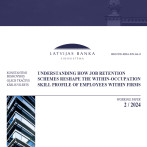Registered unemployment rate in 2013 will drop to a one-digit number
The registered unemployment rate is continuing to drop gradually (to 11.0% of the economically active population at the end of September 2012), albeit slightly slower than in the respective period of the last year. Lower unemployment implies also a reduced cyclical component of unemployment that slows down the subsequent reduction in unemployment. The number of unemployed registered with the State Employment Agency (SEA) (108.3 thousand) is the lowest in 3.5 years and a few thousand lower than at the beginning of 1999, when a wave of layoffs followed the Russian crisis.
Over the past six months, the entrepreneurs’ employment expectations have turned more pessimistic, although most entrepreneurs still predict a rise in employment instead of a drop. The question still is, however, to what extent one can rely on the future outlook of entrepreneurs to predict the future and to what extent it is simply a reflection of their evaluation of the performance of their business in the past and the current situation.
Whatever it is that determines entrepreneurs’ expectations, the deterioration in their future outlook (and global economic developments) as far has not had a major impact on Latvia’s labour market:
- Eurostat has confirmed yet again that the rise in employment in Latvia is one of the most rapid in the European Union (EU). For instance, in the second quarter of 2012, Latvia took second place in the EU (topped only by Estonia) in terms of the annual rate of increase in employment. In terms of rise in employment, Latvia became the leader already in 2011;
- The number of newly registered unemployed, i.e. the indicator, which would be the first to point to any deterioration in the labour market as it reflects layoff dynamics, is still stable and at a sufficiently low level (8.2 thousand, close to the level in 2005 and that in mid-2008);
- SEA-registered number of vacancies is gradually growing, exceeding 5 thousand threshold;
- The percentage of registered unemployed who find permanent employment within a month continues to grow (in mid-2012, the 12-month moving average value reached 4%, which is close to the indicator for 2005).
Such trends point to a gradual recovery of the labour market and to ever increasing opportunities to find employment.
The level of registered unemployment this year will not yet be written with a single-digit number. That is related to the “census adjustment” introduced in April 2012 (the number of registered unemployed divided by a smaller number of economically active population), which pushed unemployment rate up by 1.6 percentage points. Just as in previous years, the drop in unemployment will slow down during the autumn and winter, in some months a slight rise is possible. With the onset of spring, however, the drop will pick up again and in 2013 the figure reflecting the unemployment rate will probably have to be written with a one-digit number. The drop in unemployment should not exert a substantial impact on wage rise as the participation rate is growing robustly. Moreover, wage rise backed by productivity increase is sustainable and does not exert an upward pressure on inflation.
Textual error
«… …»




